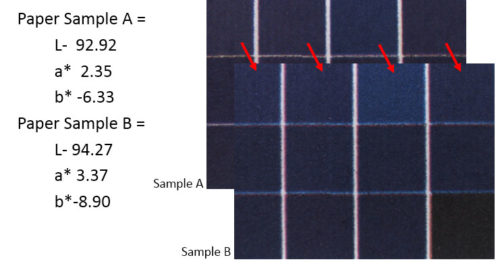In previous “Paper Specification” posts we talked about the importance of a paper’s Whiteness and Brightness values, the specific color spectrum each captures and how they affect printed inkjet color values.
We noted Brightness captures only the reflectance of the blue wave lengths of the spectrum. Whereas, whiteness captures all wave lengths to give us a measurement which better correlates with visual appearance.
Shade, on the other hand, does not measure wave lengths or light reflection, but represents the actual color of the paper. Even though it is a different measure, shade is often expressed relative to the whiteness of the paper.
A Whiter Shade of Pale
The paper industry (it’s not us, I swear) categorizes paper into 3 paper shades referred to as: True White, Blue White and Cream White.
True White paper contains no Optical Brighteners (OBA’s) and its shade is affected by bleaching, pulp and manufacturing processes. True white, reflects the entire color spectrum equally, and is the true definition of white. To brush up on your OBA’s definition, refer to article “Paper Specifications- Whiteness”.
Blue White often called “bright white or high white” paper contains various OBA levels. There are two ways to check if a paper has OBA’s. First, is if the whiteness value is over 100 and second, if when paper is folded, the crease shadow has a blue tint. Some European papers contain such high levels of OBA’s this same shadow area will visually appear more purple than blue. A blue white paper will appear “whiter” than a True White shade of paper.
Cream White- Cream white absorbs the blues that blue white reflects, and visually have a yellow shade.
Shade is important to inkjet color reproduction as the paper’s shade shows through the ink and can shift the ink’s colorant when applied to the sheet. Paper shade can affect all values of highlight, mid-tone and shadow areas of print.

Example A
Example A shows the difference which additional OBA’s make to a printed color. Sample A has OBA’s added to the sheet as seen from the b*. Sample B has much higher levels of OBA’s which increases the whiteness level to the point of starting to wash out color values making them significantly lighter. Each sample sheet was printed off the same inkjet device, settings and ink volume.
Images printed on bright white paper can provide more vibrant colors, but can also wash out darker values.
Shade is particularly important in book printing. The shade of your paper should provides visual comfort for your readers. The best choice for this depends largely on the content of your book and the color values you wish to reproduce.
As always, understanding a paper’s specifications is important as it will impact suitability to the market you may be printing for, and overall performance.
